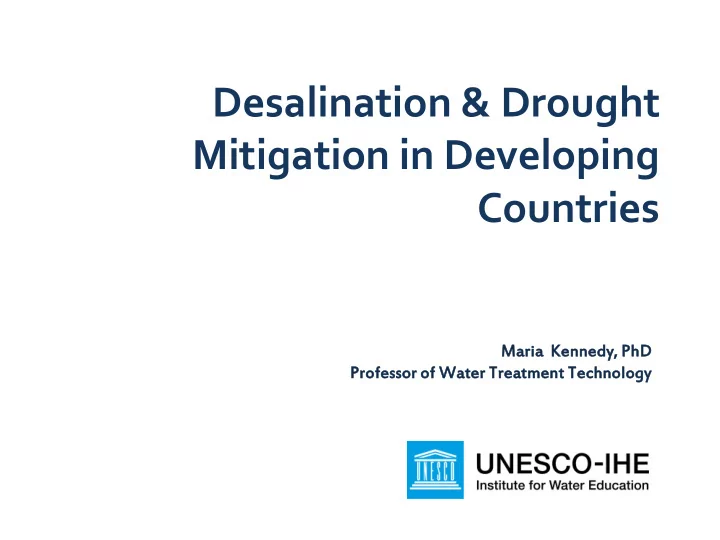

desalination: a promise for the future Desalination & Drought Mitigation in Developing Countries Maria ria Kenned nnedy, y, PhD Professor fessor of Water ter Treatm atment ent Techn chnol ology ogy
desalination: Water scarcity in 2050? a promise for the future By 2050, 78 countries (mainly developing countries) and almost 4.5 billion people affected…… Sources: FAO Aquastat (2013) World Bank (2013)
Dealing with water scarcity ? Saving water: Increasing productivity in agriculture & industry Reducing leakages in public water supply Progressive tariffs Water transport: Large distances!! Aquifer storage: River water during high flow Water reuse: Increasing reuse/recycling in industry & domestic wastewater in agriculture Desalination Brackish water Waste water Sea water
Can desalination alleviate water scarcity in developing countries? • Desalination is considered as a drought-proof water source, which does not depend on river flows, reservoir levels or climate change … • Desalination maybe an option to alleviate scarcity in industry and coastal cities.. 4
Desalination – an option for coastal cities?
Desalination capacity in Africa today? World: 80 Mm 3 /day Africa: 7.5 Mm 3 /day
Desalination in China India & Algeria
Algeria (2.7 Mm 3 /day) In Algeria, >90% of desalinated water is used by municipalities Membrane, 93 % Municipal, 93 % Thermal, 7 % Technology User Industrial, 6 % Others, <1 % category Others, <1 % Source: DesalData (2017)
India (2.6 Mm 3 /day) In India, >75% of the desalinated water is used by industry Municipal, 25 % Membrane, 81 % User Thermal, 19 % Industrial, 75 % Technology Category Others, 0 % Others, 0 % Source: DesalData (2017)
China (4.5 Mm 3 /day) In China, >80% of the desalinated water is used by industry Membrane, 78 % Municipal, 18 % Thermal, 6 % User Industrial, 79 % Technology Others, 17 % category Others, 3 % Source: DesalData (2017
What are the key challenges to implement desalination in developing countries… POTENTIAL ENVIRONMENTAL IMPACTS : – Concentrate and chemical discharges – Energy and GHG emissions 11
Disperse concentrate through multiport diffuser in a suitable marine site Treatment of all backwashing and cleaning wastes to reduce marine pollution Use of subsurface or submerged intakes with low intake velocities Improve recyclability and reuse of materials
Is energy demand significant in desalination ? • depends on a society's values, economic potentials, politics, and existing environmental regulations …
How much energy is required to desalinate water in Africa today ( current capacity ≈7.5 Mm 3 /day)? • Assume: total installed capacity realized with SWRO ( ≈3 kWh/m 3 ) • Total energy requirment for desalination in Africa today: Capacity x 3 kWh/m 3 = 7.5 10 6 m 3 /day x 3 kWh/m 3 = 22.5 10 6 kWh = 0.02 10 9 kWh 0.3 % of the electrical power consumption in Africa today!
Energy - a key issue due to global warming! Q: How much energy is used in Africa today ? A : Primary energy use is ≈ 8,000 TWh/year by 1 billion people. Q: How much water can be desalted with that much energy? A: Assume : SWRO (3 kWh/m 3 ); conversion factor from primary to electrical energy (30%); Pop. of Africa: 1 billion people = 800 m 3 / capita per year. Domestic use : requires ≈ 100 L per capita/ day or 40 m 3 per capita/year 5% of Africa’s current energy consumption would be required to meet their domestic water demand by desalination
Desalination using renewable energy? • No large desalination plant driven by RE! • Compensation measures only (all Australian projects) • Small, stand-alone desalination systems Solar energy Wind / Tides Heat (collector) Radiation (PV cell) Turbine Solar stills Non-concentrating collectors Concentrating collectors - solar pond - parabolic design (trough, dish) - flat plate or tube collectors - flat mirrors, e.g. Fresnel - power tower (>1000 ° C) (e.g., for domestic purposes) Electricity Mechanical MD MED- MSF ED RO MED- TVC MVC
Concluding remarks • By 2050, we may have 4.5 billion people suffering from water scarcity/stress/vulnerability on the planet, and > 95% of these people may live in developing countries... • Desalination is technically feasible on a large scale and can be applied to solve water scarcity in coastal cities. • Industry already has turned to desalination to meet their water needs (India & China) – this strategy may be applied to other developed and developing countries... • ENERGY is a key issue and will remain a challenge because of the high cost of renewable energy....... • Capacity development and training........
Desalination costs Cost breakdown for SWRO Cost indication Euro/m 3 Spares Chemicals 4% 6% Seawater reverse osmosis 0.50 – 1.00 Brackish water reverse osmosis 0.25 – 0.50 O&M Capital 14% recovery Electrodialysis 0.25 – 0.50 41% Nanofiltration 0.15 – 0.25 Membranes 16% Ultra/microfiltration 0.05 – 0.10 Power 19% Source: Ghaffour et al. 2013
Can water reuse solve water scarcity in developing countries? • Desalination is considered as a drought-proof water source, which does not depend on river flows, reservoir levels or climate change … • Desalination maybe an option to alleviate scarcity in industry and coastal cities.. 19
Recommend
More recommend